Elise Model Guide
Elise S1, 1996
Type 111
VIN: T 0017 onwards 
Conceived as a low production model, the Elise has shattered sales expectations and returned Lotus to the forefront of sports car production. This car has also spawned some very interesting limited editions, including the 340R, the Exige coupe, and several motorsport derivatives.
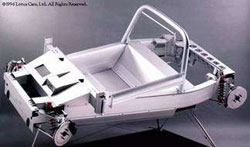 The standard engine is a Rover K-series 1796cc with 4 cylinders in line, and mid mounted transversely. It has an aluminium engine block and aluminium cylinder head with double overhead camshaft, hydraulic tappets, and fuel injection. Peak power is 118bhp (88Kw) at 5500rpm, peak torque is 122 lb.ft (165Nm) at 3000rpm Click here to see the S1 Brochure
The standard engine is a Rover K-series 1796cc with 4 cylinders in line, and mid mounted transversely. It has an aluminium engine block and aluminium cylinder head with double overhead camshaft, hydraulic tappets, and fuel injection. Peak power is 118bhp (88Kw) at 5500rpm, peak torque is 122 lb.ft (165Nm) at 3000rpm Click here to see the S1 Brochure
GT1, 1997
Type 115
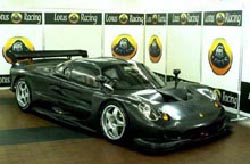

In 1997 Lotus unveiled the Lotus Elise GT1, a derivative of the Lotus Elise and powered by a 3.5 litre eight-cylinder engine. A Hewland six-speed sequential gear box helped transfer the 580 horsepower to the rear wheels. The body is carbon-fibre and the chassis is an aluminium unit borrowed from the Elise. Ventilated disc brakes were fitted on all four-corners. Performance is 0-60 in 3.8 seconds, and top speed is 200 mph. For more info click here
Twin Turbo V8, Displacement 3506cc
Transmission: 6-Speed Manual
Horsepower 580 BHP at 7500 rpm
Torque 390Nm / 288lb/ft at 6500 rpm
0-60 mph in 3.8 sec, Top Speed 312 kph / 195 mph
Brakes: Vented Discs
Weight: 1052 kgs / 2315 lbs
Sport 135, 1998
VIN: X 5401-5450, 6001-6035
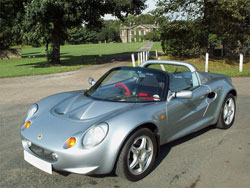
The Sport 135 was first launched as a limited run of 50 in November 1998, VIN: X 5401 - 5450. It has some improvements to increase the power to 135bhp (although it seems 145bhp is not unusual). Other additions include close-ratio gearbox, sports exhaust, drilled brake discs (cast iron), blue tinted metallic silver paint (Quicksilver), dark blue hood, corbeau sport seats, silver roll over bar, racing steering wheel, headlamp covers, driving lights, and unique Sport 135 body graphics. The catalytic converter is replaced by a through pipe which means the car has to be homologated and this is the main reason for the limited first production run.
 50th Anniversary Edition, 1998
50th Anniversary Edition, 1998
VIN: X 5463 - 5816
This is a special edition car based on the standard model. It was launched in late 1998 and only 50 were produced. It was available in one colour only, a metallic green with two tone green/beige leather seats & gold wheels.
111S, Jan 1999
VIN: X 5722
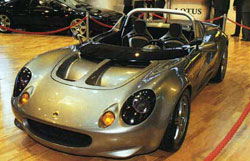
This car was originally called the Sprint and shown in a windowless format, but later re-named the 111S when it was launched at the Geneva Motorshow in 1999. The main difference on this model is that it has the Rover K-series 1.8 Variable Valve Control (VVC) engine which gives 143bhp giving improved performance figures of 0-60 in 5.38 secs, 0-100 in 14.4 secs, and a maximum speed 133mph.
The VVC progressively changes the cam profile, unlike the Honda VTEC engine which is more of an on/off action. These means that it also comes into effect lower down the rev range, giving a wider and smoother power band.
The 111S also features wider 225 section rear tyres and some controversial cosmetic changes such as new 6-spoke wheels, a spoiler, an egg-crate grille, and a carbon effect dash. It also has aluminium window winders and optional 111S decals.
This car was replaced by a 160bhp version of the standard engine named the Lotus Sport 160 in August 2000.
My 111S page can be found here
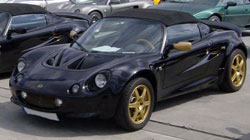 Heritage / Type 79 (JPS), July 1999
Heritage / Type 79 (JPS), July 1999
A limited run of 100 left-hand drive Elises in Black with gold wheels and grilles. The interior has a yellow/gold chamois effect seat panel and yellow/gold dash. These were a special run at the request of the Italian dealer network and although they are in JPS colours (gold instead of the original yellow), they are badged as 'Heritage' since Lotus don't hold the rights to the JPS mark. A limited run of 50 was planned in right-hand drive form and were sold as the Type 79. These were available with either standard or VVC engines.
Type 49, Oct 1999
Unveiled at the 1999 London Motorshow at Earls Court, this special edition Elise is painted in the same red, gold and white colour scheme as the Lotus Type 49 Formula One racing car. Also available with a yellow, white and gold colour combination. It was available with the standard 1.8 or the VVC engine.
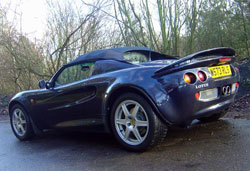 Millenium Edition, Oct 99
Millenium Edition, Oct 99
VIN: X 8177 (approx.)
Available based on either standard or 111S versions. Atlantis Blue body colour. All cars have blue Alcantara steering wheel pad and sill trim panels, 111S type black leather seats with blue Alcantara centres. Standard versions also have 111S type road wheels, rear wheelarch spats and headlamp covers. Cars were usually supplied with a range of dealer fitted Lotus accessories.
340R, 1999
VIN: Y 0004 to 0009, 9640+
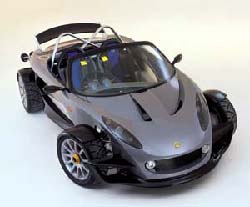
Launched at the Hippodrome in London in August 1999. First called the 340R due to it's power to weight ratio (170bhp and 500kg) and because only 340 were built.
The 340R is powered by a 1.8-litre VHPD (Very High Performance Derivative) K series engine producing 180PS. And in an extremely light car, equipped with a close ratio gearbox, giving a performance of 0-60mph in 4.4secs, and a top speed of 133mph (214km/h).
The addition of the power enhancement as part of the track pack (uprated ECU, no cat, motorsports silencer, 101 inlet cam pulley, 82deg t'stat, oil breather catch tank) give 195bhp. The dry weight of the standard car is 658kg, the power enhanced version being about 5kg less due to the lighter exhaust. The full track prepared car, stripped out and with the track pack weighs 571kg.
M250, Frankfurt Motorshow 1999
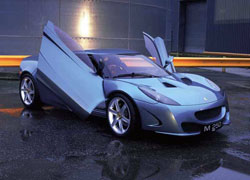
The concept behind M250 was to "produce another superlative driverΆs car in the same mould as the Elise, but with technical refinements and enhancements made possible through what weΆve learned from over 50 years of sportscar development."
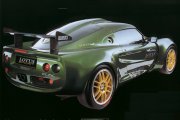
Motorsport Elise, 2000
Designed for a special Lotus managed race series it features a tuned VHPD K-series engine giving in excess of 200bhp. This Elise based coupe has lots of carbon fibre components. (See also S1 Exige below)
Sport 160, Feb 2000
SVA: VIN: Y 0601 to 0650
WVTA: VIN: Y 0651 onwards
 The Sport 160 was launched in February 2000. It featured an improved Sport 135 head with new cams and ECU. The first 50 cars had a GEMs ECU, later cars had a EFI Technology ECU. The GEMs unit lives in the engine bay, the EFI lives in the boot.
The Sport 160 was launched in February 2000. It featured an improved Sport 135 head with new cams and ECU. The first 50 cars had a GEMs ECU, later cars had a EFI Technology ECU. The GEMs unit lives in the engine bay, the EFI lives in the boot.
The first 50 Sport 160 cars underwent Single Vehicle type Approval (SVA) testing (identified by a VIN between 0601 and 0650), and are factory built with catalytic converters and 'Sport' exhaust to produce 160PS @ 7000 rpm and 178Nm torque @ 5000 rpm. Subsequent cars were Whole Vehicle Type Approved (WVTA) and were factory built with catalytic converters, 111S exhausts and dual intake air cleaner/muffler assemblies to produce approx. 150 PS, but were readily converted to 160 PS specification by carrying out an intake airbox modification, and fitting the 'sport' exhaust
For more info on the 160, and a link to the online brochure, click here
Exige, Apr 2000
VIN: Y 0001 (Character 13 = 8) - model specific serial number sequence
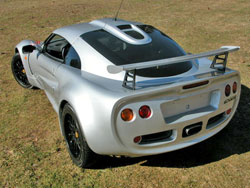
Officially launched by Lotus at Brands Hatch at the first round of the Lotus Motor Sport Elise race series (9th April 2000). This fixed roof coupe has the same 170bhp engine as the 340R with option to upgrade to 190bhp. It features Lotus sport suspension, the close ratio gearbox and anthracite wheels. Large carbon rear wing similar to Esprit 350 Sport. Optional sports exhaust and 340R style seats are available.










 Απάντηση με παράθεση
Απάντηση με παράθεση




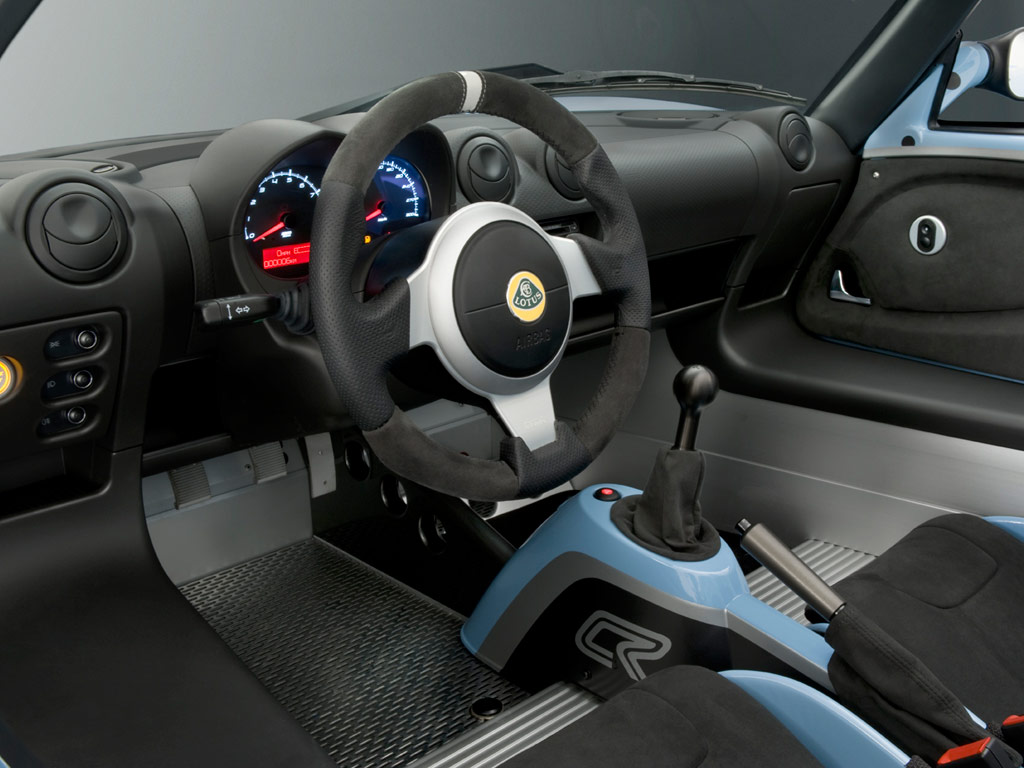


 The standard engine is a Rover K-series 1796cc with 4 cylinders in line, and mid mounted transversely. It has an aluminium engine block and aluminium cylinder head with double overhead camshaft, hydraulic tappets, and fuel injection. Peak power is 118bhp (88Kw) at 5500rpm, peak torque is 122 lb.ft (165Nm) at 3000rpm Click
The standard engine is a Rover K-series 1796cc with 4 cylinders in line, and mid mounted transversely. It has an aluminium engine block and aluminium cylinder head with double overhead camshaft, hydraulic tappets, and fuel injection. Peak power is 118bhp (88Kw) at 5500rpm, peak torque is 122 lb.ft (165Nm) at 3000rpm Click 

 The Sport 135 was first launched as a limited run of 50 in November 1998, VIN: X 5401 - 5450. It has some improvements to increase the power to 135bhp (although it seems 145bhp is not unusual). Other additions include close-ratio gearbox, sports exhaust, drilled brake discs (cast iron), blue tinted metallic silver paint (Quicksilver), dark blue hood, corbeau sport seats, silver roll over bar, racing steering wheel, headlamp covers, driving lights, and unique Sport 135 body graphics. The catalytic converter is replaced by a through pipe which means the car has to be homologated and this is the main reason for the limited first production run.
The Sport 135 was first launched as a limited run of 50 in November 1998, VIN: X 5401 - 5450. It has some improvements to increase the power to 135bhp (although it seems 145bhp is not unusual). Other additions include close-ratio gearbox, sports exhaust, drilled brake discs (cast iron), blue tinted metallic silver paint (Quicksilver), dark blue hood, corbeau sport seats, silver roll over bar, racing steering wheel, headlamp covers, driving lights, and unique Sport 135 body graphics. The catalytic converter is replaced by a through pipe which means the car has to be homologated and this is the main reason for the limited first production run. 50th Anniversary Edition, 1998
50th Anniversary Edition, 1998 
 Heritage / Type 79 (JPS), July 1999
Heritage / Type 79 (JPS), July 1999
 Millenium Edition, Oct 99
Millenium Edition, Oct 99  Launched at the Hippodrome in London in August 1999. First called the 340R due to it's power to weight ratio (170bhp and 500kg) and because only 340 were built.
Launched at the Hippodrome in London in August 1999. First called the 340R due to it's power to weight ratio (170bhp and 500kg) and because only 340 were built. The concept behind M250 was to "produce another superlative driverΆs car in the same mould as the Elise, but with technical refinements and enhancements made possible through what weΆve learned from over 50 years of sportscar development."
The concept behind M250 was to "produce another superlative driverΆs car in the same mould as the Elise, but with technical refinements and enhancements made possible through what weΆve learned from over 50 years of sportscar development."
 Officially launched by Lotus at Brands Hatch at the first round of the Lotus Motor Sport Elise race series (9th April 2000). This fixed roof coupe has the same 170bhp engine as the 340R with option to upgrade to 190bhp. It features Lotus sport suspension, the close ratio gearbox and anthracite wheels. Large carbon rear wing similar to Esprit 350 Sport. Optional sports exhaust and 340R style seats are available.
Officially launched by Lotus at Brands Hatch at the first round of the Lotus Motor Sport Elise race series (9th April 2000). This fixed roof coupe has the same 170bhp engine as the 340R with option to upgrade to 190bhp. It features Lotus sport suspension, the close ratio gearbox and anthracite wheels. Large carbon rear wing similar to Esprit 350 Sport. Optional sports exhaust and 340R style seats are available.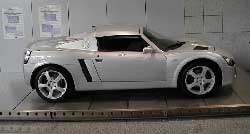 Nicknamed the Skipton in Hethel during development, Lotus has worked in co-operation with designers and engineers from the Opel/Vauxhall International Technical Development Centre in Ruesselsheim, Germany, to build the VX200 (named the Speedster for the European market). Lotus built the original concept show car - one of the stars of the March 1999 Geneva Motorshow. Powered by Opel/Vauxhall's all-new, aluminium ECOTEC, 2.2-liter, four-cylinder gasoline engine.
Nicknamed the Skipton in Hethel during development, Lotus has worked in co-operation with designers and engineers from the Opel/Vauxhall International Technical Development Centre in Ruesselsheim, Germany, to build the VX200 (named the Speedster for the European market). Lotus built the original concept show car - one of the stars of the March 1999 Geneva Motorshow. Powered by Opel/Vauxhall's all-new, aluminium ECOTEC, 2.2-liter, four-cylinder gasoline engine. 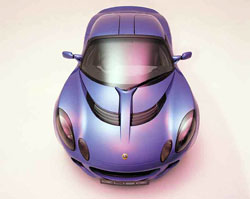
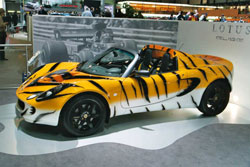
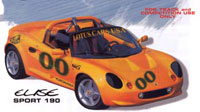 Sport 190, January 2001
Sport 190, January 2001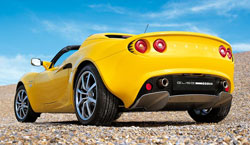 This car is identical to the 111 but features leather seats and trim, an upgraded stereo and carpets.
This car is identical to the 111 but features leather seats and trim, an upgraded stereo and carpets.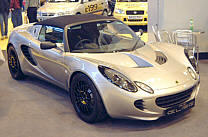 Elise S2 Sport 190, 2002
Elise S2 Sport 190, 2002 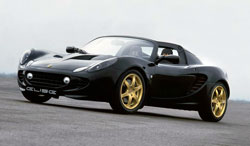
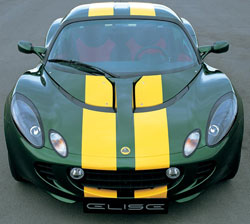
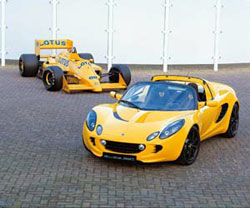 Type 99T is a celebration of one of the most distinctive Lotus Formula One cars. Unveiled in London on 3rd February 1987 the Lotus 99T holds the honour of being the last ever Lotus Formula One car to win a Grand Prix.Painted in unique ΅Saffron Yellow' with subtle blue detailing to mirror that of the original race car, the Elise Type 99T commemorates one of the most recognisable cars in the history of Formula One.
Type 99T is a celebration of one of the most distinctive Lotus Formula One cars. Unveiled in London on 3rd February 1987 the Lotus 99T holds the honour of being the last ever Lotus Formula One car to win a Grand Prix.Painted in unique ΅Saffron Yellow' with subtle blue detailing to mirror that of the original race car, the Elise Type 99T commemorates one of the most recognisable cars in the history of Formula One. 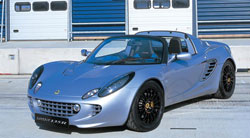 Developed by Lotus Sport and Performance in conjunction with the Lotus Ride and Handling team to develop a sports suspension set-up giving its user total control over ride height settings to maximise the cars performance in any environment. Following on from this, Lotus Sport and Performance has redesigned the flow characteristics of the cylinder head specifically for the 135R to offer greater flexibility throughout the rev range.
Developed by Lotus Sport and Performance in conjunction with the Lotus Ride and Handling team to develop a sports suspension set-up giving its user total control over ride height settings to maximise the cars performance in any environment. Following on from this, Lotus Sport and Performance has redesigned the flow characteristics of the cylinder head specifically for the 135R to offer greater flexibility throughout the rev range.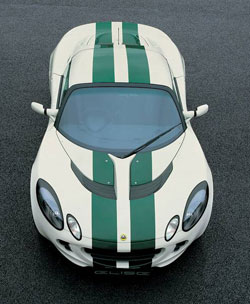 In addition to the engine modifications, the 3-piece F1 style diffuser and exhaust system has been utilised to further enhance the performance and character of the car.
In addition to the engine modifications, the 3-piece F1 style diffuser and exhaust system has been utilised to further enhance the performance and character of the car.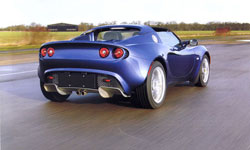
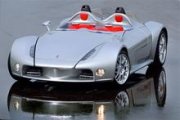
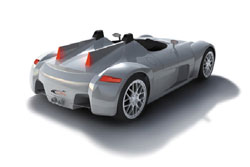
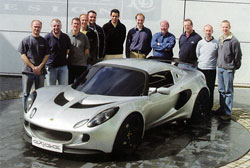
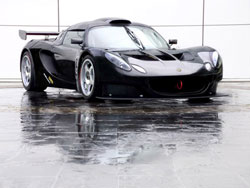 A direct motorsport derivative of the successful Lotus Exige. This Lotus designed and engineered race car was part manufactured by RTN, the team responsible for the Le Mans winning Bentley, using the latest motorsport techniques and procedures to produce a lightweight yet strong carbonfibre bodywork structure around the standard road-going Lotus Exige Aluminium extruded and bonded chassis.
A direct motorsport derivative of the successful Lotus Exige. This Lotus designed and engineered race car was part manufactured by RTN, the team responsible for the Le Mans winning Bentley, using the latest motorsport techniques and procedures to produce a lightweight yet strong carbonfibre bodywork structure around the standard road-going Lotus Exige Aluminium extruded and bonded chassis.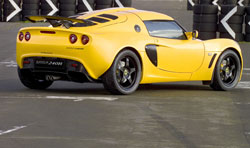 Limited edition of 50 units produced as post registration official factory conversions of '05 Exige by the Lotus Sport workshops at Hethel, for U.K. and certain overseas territories (up to 40 sold in the EU, the remainder mainly in Japan). The car is not identifiable from the VIN coding. They are only available in Sport Yellow or Sport Black, and has a unique interior trim in black with Lotus Sport Yellow highlights in leather.
Limited edition of 50 units produced as post registration official factory conversions of '05 Exige by the Lotus Sport workshops at Hethel, for U.K. and certain overseas territories (up to 40 sold in the EU, the remainder mainly in Japan). The car is not identifiable from the VIN coding. They are only available in Sport Yellow or Sport Black, and has a unique interior trim in black with Lotus Sport Yellow highlights in leather.

